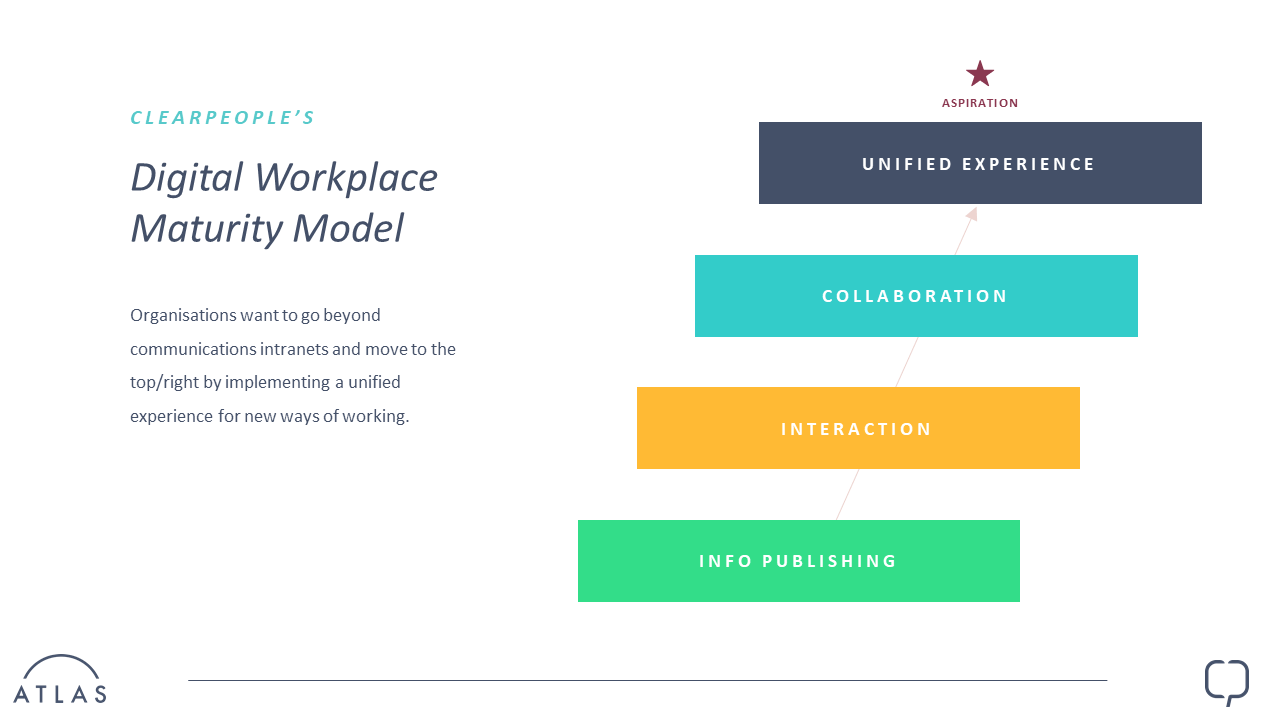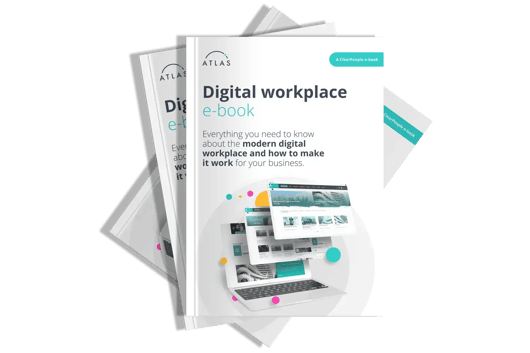The digital workplace maturity model guides organisations on how to drive more strategic value out of their digital workplace: increasing engagement, innovation, efficiencies and productivity.
As businesses aim to satisfy the ever-growing demands of their employees and customers, the way they interact and engage with them also has to evolve. The power balance in the employer-employee relationship has shifted more towards the employee as they want the ability to work from anywhere and to be able to stay connected through smart devices.
Digital Workplace Definition
The digital workplace is central to this engagement. There are numerous definitions of the digital workplace and the definition of digital workplace has changed over time as trends evolve, especially since the scope of intranet features has expanded considerably in the past 20 years.
Let’s start with Microsoft’s definition of a digital workplace: “The digital workplace encompasses all the technologies people use to get work done in today's workplace”. The Digital Workplace Group similarly describe it as “the collection of all the digital tools provided by an organisation to allow its employees to do their jobs”.
At ClearPeople, we define the digital workplace as a "collection of digital technologies that optimises the employee experience and provides new and better ways of working".
Organisations are benefiting from the digital workplace through increased productivity and innovation, and generally increased flexibility and adaptability. With organisations collaborating more globally and with more diverse and global staff, employees are enabled to work from anywhere in the world.
The digital workplace can create its own challenges: including security, managing employee and employer expectations especially in terms of always being “on” and if implemented incorrectly, it can have a negative impact on the engagement and productivity of workers.
Different organisations have different priorities and requirements and thus there is no “one size fits all” approach to this technology evolution, but there are key stages in how you can optimise the benefits of your digital workplace. Maturity frameworks are commonly used to depict how processes and technologies mature over time. They enable users to quickly recognise the maturity of a specific solution. They can also help by guiding organisations on how to be more proactive and how to re-interpret their corporate culture around the digital workplace.
Deloitte’s Digital Workplace Framework
Even though this framework is over ten years old, it has concepts that are relevant today. The digital workplace framework includes four layers covering the following components:
- Use: collaborate, communicate, connect
The digital workplace is all about the employees’ ability to do their job by collaborating, communicating and connecting with others. The goal is to forge productive business relationships within and beyond natural work groups and to enable knowledge sharing across the organization.
- Technology: the digital toolbox
Technology enables the digital workplace. Each organisation already has a digital workplace toolbox with different tools. The key is to adopt the right tools for your employees to do their jobs.
- Control: governance, risk and compliance
The effective use of technology in the digital workplace is underpinned by appropriate controls. This means you must support the digital workplace with appropriate governance structures and management processes. Information flow and use must also comply with your organisation’s policies and industry regulations.
- Business drivers: measurable business value
As with any core initiative, it is essential for business needs to drive the digital workplace. To deliver the necessary benefits, the direction of your organisation should guide the direction of your digital workplace.
ClearPeople's Digital Workplace Maturity Model
We have evolved an intranet maturity model (Razorfish, 2006) into our own digital workplace maturity model that illustrates how connecting people, processes, systems and information can drive more strategic value out of your digital workplace. This framework can be used to depict how the basic intranet evolves from department-driven efforts into a unified digital workplace. The model covers:
- Sponsorship: Funding and executive sponsorship for delivery and ongoing efforts.
- Culture: A company’s approach to innovation and how it empowers employees with technology.This has a great impact on the design, evolution and success of any digital workplace.
- Governance: Organisational structures, policies and procedures.
- User Needs: Specific needs of users and considerations driving the user experience.
- Technology: A company’s use and adoption of emerging technology.
- Metrics: How well a company uses data to measure success and inform strategy.

Stage 1 – Information Publishing
This is your classic intranet, primarily used for communication and information sharing, meeting the most basic of employee needs such as the dissemination of news, providing corporate information, policies and relevant templates for each department.
Sponsorship: Usually sponsored by department managers such as IT or Marketing.
Culture: Traditional view that most communication and collaboration takes place in the office.
Governance: Lack of formal governance models.
User needs: Rarely includes significant functionality.
Technology: In-house solution, out-of-the-box SharePoint or similar.
Metrics: Stage 1 is unlikely to be measured against business objectives.
Stage 2 – Interaction
This is a more sophisticated self-service intranet where employees are provided with information and services that enable them to better manage their work and they can contribute to the intranet through the available tools.
Sponsorship: Department managers - IT and/or Marketing.
Culture: Business invests into company-wide communication and collaboration across some areas of the business.
Governance: Formal governance models are introduced.
User needs: Provide well-designed experiences relevant to repeat usage around core tasks, users quickly adopt the intranet.
Technology: Bespoke or third-party intranet solutions. Start to leverage modern architectures to promote speed and flexibility.
Metrics: Measurement is focused on specific outcomes such as usage, saving employee time etc.
Stage 3 – Collaboration
This is where the real meaning of the digital workplace starts to develop, focused on communication, collaboration and social tools so that employees have a single interface through which they can work together and share knowledge with one another via multiple devices.
Sponsorship: C-Level.
Culture: Digital tools start being used for innovation.
Governance: Formal governance models are used. Policies and procedures are documented, standardised and integrated.
User needs: Usability experience is strong.
Technology: Enterprise search and people directory more important. Likely to have more personalisation features and integration of some applications. Technology budget is fluid to allow for shifting priorities. Measure technology teams by business outcomes not just system up-time.
Metrics: Clear and quantifiable goals for measuring the success of the digital workplace. Employee insights inform digital workplace design and development.
Stage 4 – Unified Experience
The focus of this stage is on encompassing all the digital technologies people use to get work done into one single, consolidated platform. This is where the big and repeatable business ROI is found, by getting the digital workplace to work for you as well as spending less time to create more valuable outcomes. Together with modern approaches and cutting-edge AI and automation technologies, the unified experience is a reality today.
Sponsorship: CEO, C-Level and Digital Workplace (DW) leaders. DW leaders work with IT, HR and Line of Business leaders to determine demand and opportunities. They also provide the direction, oversight to develop and communicate the product, policies and processes that are needed, and ensures the importance of the DW is understood across the business.
Culture: The organisation's competitive strategy depends on the digital workplace but to achieve a consolidated workplace, it requires organisational and technical changes and therefore sponsorship from the CEO.
Governance: Formal governance models.
User needs: Personalised and seamless. The workplace interface is fundamentally concerned with bringing simplicity to all the digital touch-points that an employee may have. It is not only incredibly usable but contextually aware.
Technology: Integrate legacy applications, interfaces and portals into a single, consolidated dynamic interface.
Metrics: Clear goals where employees fully understand how their performance ties to corporate digital goals. Feed lessons learned, customer and employee insight back into strategy.
A digital workplace is working when:
-
-
-
- Mundane tasks have been vastly reduced
- Productivity has increased
- Employee engagement levels are high
- Employees, whether working remotely, in the office or on site, are more connected, informed, and aligned
- Attracting and retaining top talent has become easier
- Investment in technology is maximised.
Stages by Purpose
| Purpose |
Stages 1 to 3
|
Stage 4
|
|
Key objective
|
Provide employee information and possibly insight into the organisation
|
Get work done, build relationships and facilitate knowledge sharing
|
|
Communication style
|
Push one-way communication, potentially with some feedback mechanisms
|
Enables employee-to-employee communication and user-generated content
|
|
Collaboration
|
Must switch between Teams, Intranet and other collaboration tools
|
Seamless and integrated experience
|
|
Knowledge
|
Authoritative knowledge
|
Expert knowledge, explicit knowledge, metaknowledge, imperative knowledge and collective intelligence
|
|
Personalisation
|
Broadcast as well as targeted by geography and team
|
Broadcast, as well as targeted by role and individual
|
|
Applications
|
Links to external applications
|
Key applications either integrated or information surfaced within the Digital Workplace
|
More Digital Workplace reads:









